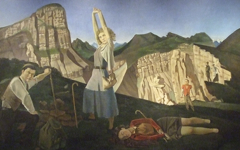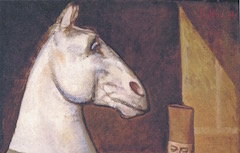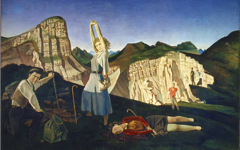Balthus’ The White Skirt (1937)
Sometimes it can be difficult to imagine painters as poets because we tend to think of them as copying the exterior world. Not Balthus. Not only do his paintings look mysteriously poetic but his mother's lover during Balthus' most impressionable years was the poet Rainer Maria Rilke who took an abiding interest in the young painter.
How, then, can we find poetic meaning in this portrait?
Click next thumbnail to continue

Top: Detail of Balthus' White Skirt (1937)
Bottom: Detail of Poussin's Self-portrait (1650)
Click image to enlarge.
First of all, as I show in Balthus' The Mountain (1937) and his Portrait of André Derain (1936) the young painter identified with Poussin. Just as he emphasized similarities between Derain's face and Poussin's, he did so again here with Antoinette de Watteville whom he married the same year. She had also been Derain's model in his portrait. In both paintings her long, wavy and centrally parted hair identifies her as a feminine alter ego of Poussin. The hair may also be intended to suggest the hairs of a paintbrush1 while the chair's gold frame echoes the frames of Poussin's paintings in the background to his self-portrait.
Click next thumbnail to continue
Now take a look at the curtains, the only other feature beyond the girl and chair.
If you knew - as I argue in an entry Cubism Explained - that Cubism was a means to depict a mental image, you would appreciate similar meaning behind complex fabric patterns. Balthus played on that little-known tradition when he formed the contours of the curtain into those of his nose and far eye. The scene at left, then, represents a mental image of himself as both artist and model inside his androgynous mind.
Click next thumbnail to continue

Left: Detail of Balthus' The White Skirt (1937)
Center: Detail of Balthus' Self-portrait (1940)
Right: Diagram of the detail on the left
Click image to enlarge.
Although the self-portrait (center) post-dates White Skirt, the turn of his head was probably similar in other now-lost self-portraits.2 Nevertheless, you can still see from the diagram (right) how the lines of his nose, nostril and far eye are formed in the folds of the curtain, a link no-one but artists is ever likely to have seen before.3
Click next thumbnail to continue
Balthus turned his wife and model into his own reincarnation as Poussin's heir. With her head angled and eyes open she resembles a dreaming artist and, assuming the self-portrait depicts a characteristic pose, any similarity between the two figures must be significant. Like him, she sits in a chair wearing a white shirt with long legs casually crossed. Her left arm is bent like his while her painting-hand droops below the chair-arm, its loose fingers mimicking the hairs of a brush, a manual metaphor Matisse had used too.4
See conclusion below
Even the colors Balthus chose for the curtains are significant. The red picks up the color of his cheeks in the self-portrait, the only spot of red anywhere, while the green and khaki colors on the right are the same as on other areas of his skin. There must have once been an earlier self-portrait with similar features.
Once a painting is visualized within the framework the artist roughly intended, doors open to further insights based on a firmer foundation. Given how little is known about the methodology of art, there are likely to be many more insights into these images as time goes on.
More Works by Balthus
In a short addendum to Part 1, see how Balthus conveyed his alter ego

Balthus’ The Mountain (1937) Part 2
Notes:
1. Joseph Koerner has suggested that Dürer used the hairs of a piece fur clothing to suggest the hairs of a paintbrush. See Joseph Leo Koerner, The Moment of Self-Portraiture in German Renaissance Art (University of Chicago Press) 1993, pp. 167-9, 186
2. Balthus had a habit of destroying compositional sketches on completing a painting, probably to obscure his sources and thus his meaning. How did he destroy them? Apparently he threw them on the studio floor and walked over them.
3. The sinuous curve of the artist's nose is echoed in an exaggerated way in the curving line on the left of the one noted in the diagram.
4. See Matisse's The Three Sisters (1916). An entry will be added on this painting, hopefully soon.
Original Publication Date on EPPH: 02 Jul 2012. | Updated: 0. © Simon Abrahams. Articles on this site are the copyright of Simon Abrahams. To use copyrighted material in print or other media for purposes beyond 'fair use', you must obtain permission from the copyright owner. Websites may link to this page without permission (please do) but may not reproduce the material on their own site without crediting Simon Abrahams and EPPH.





